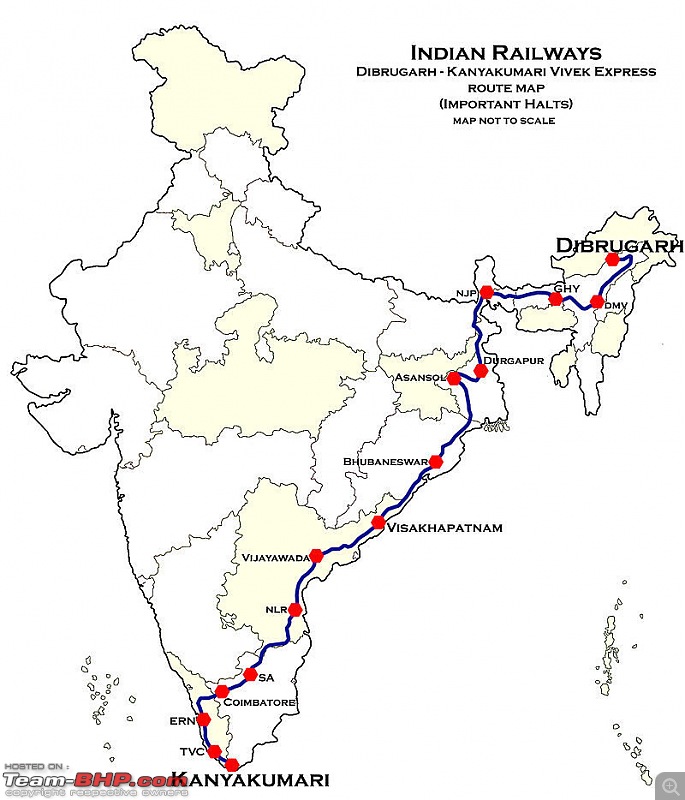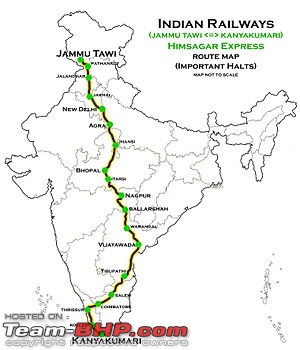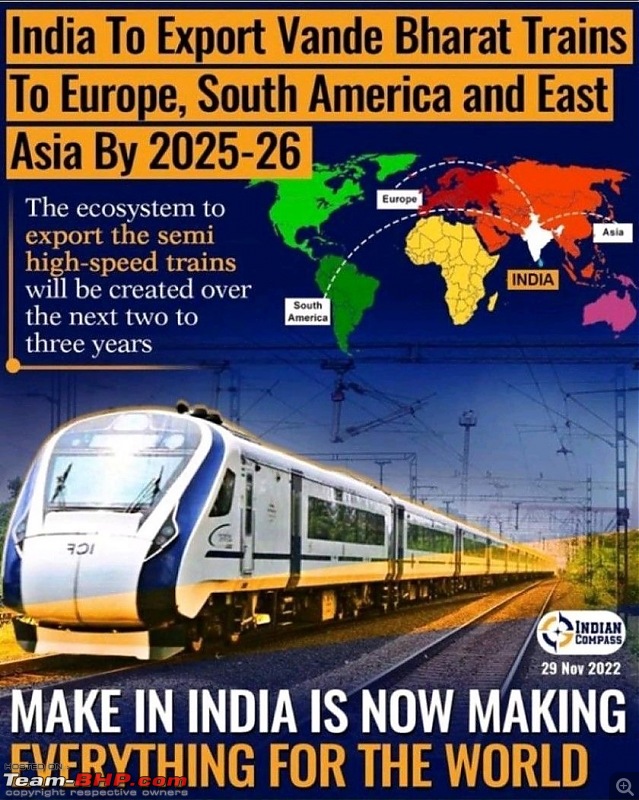Team-BHP
(
https://www.team-bhp.com/forum/)
Quote:
Originally Posted by ruzbehxyz
(Post 5498259)
Details of the Vande Bharat 2.0 (VB2) trains launched on 30th Sep. 2022.
|
Really pleased to see that IR isn't resting on its laurels and is continuing to update the VB trains incrementally. This is very heartening. I know the big Air India news will steal all the transport airwaves but I'm really excited by the prospect of the railway system finally starting to see meaningful improvement. Environmentally speaking mass rail transport is critical to meet goals and I think the sensible (and feasible) speeds of the VB are much more useful than a silver bullet solution like a bullet train. I'd love to see a day when VB style trains become de rigeur in India. I wonder if eventually you could see some variant replacing traditional commuter locomotives (this might be a stretch too far).
Anyway, thanks for sharing your experiences. For the first time in forever I'm keen to sample a train when I'm next in India.
Quote:
Originally Posted by ads11
(Post 5499432)
Really pleased to see that IR isn't resting on its laurels and is continuing to update the VB trains incrementally. This is very heartening.
|
In fact Vande Bharat 3 (VB3) is also in the making. It will mainly have sleeper coaches so that these trains can be operated for longer / overnight distances. Current VD 1 and 2 are seater trains for journeys less than 24 hours.
By 2026, there will be in service the fourth generation Vande Bharat (VB4) trains which will have a maximum speed of more than 200 km/h and the coaches will be made of a lightweight aluminium alloy.
Quote:
Originally Posted by Fx14
(Post 5496990)
However after researching a bit, got to know that the seat allocation is done automatically basis certain algorithms to ensure safety of the coach at high speeds w.r.t. ensuring that the centre of gravity for the coach is maintained at all times basis the expected occupancy levels. Imagine a scenario where if permitted, a big group of people book all seats towards one end of a coach rendering it very heavy with their accompanying luggage and the other end of the coach is empty and then hurtling at high speed.
|
This is more an urban legends recently hyped via whatsapp forwards and quora answers. Total weight of passengers is not significant enough to change the centre of gravity. Generally railway coaches are around 50-60 tons, with most weight at bottom (wheels/brake etc) Even with full load, total passenger weight will be 6-7 tons conservatively (72 passengers in sleeper) which is only about ~10-15% increase in weight.
Recently took the Vande Bharat from Delhi to Chandigarh. Boarded the Executive Class and in bang 2 hours and 45 mins, the train arrived at Chandigarh junction.
This was the fastest I have done this route. 3 hours is what it took me once (2018) from Airport road to Delhi airport.
Never would I ever think of traveling in the Volvo after traveling in the VB. Clean, Fast, Non-tiring, tummy filling journey.
In EC specifically, they kept in feeding you. Cutlet, Poha, Kellogg's cornflakes, Milk, Tea/Coffee, Cupcake, Salted Lassi, Curd, Tetra juice.. that's a lot of decent food
Quote:
Originally Posted by 84.monsoon
(Post 5498873)
Completely agree. The weight of an ICF coach is 60 tonnes. With 72 passengers on board, the weight of the passengers collectively will be about 5 tonnes.
|
Exactly. In Engineering, there is the concept of live load and dead load. The latter (i.e. objects) are always exponentially higher mass than the ones that move. Design is done based on the dead load, on top of that a factor of safety of 1.5- 2.5 is applied, which covers much more than any that live load can contribute in any way of distribution.
The same concept applies to buildings. A floor will not fall off or bend like a lever if many people (or even massive furniture) stand on one edge. The floor slab is way heavier.
Basic physics and math should be taught compulsorily in journalism courses. :Frustrati
Quote:
Originally Posted by mayukh42
(Post 5500182)
The same concept applies to buildings. A floor will not fall off or bend like a lever if many people (or even massive furniture) stand on one edge. The floor slab is way heavier.
Basic physics and math should be taught compulsorily in journalism courses. :Frustrati
|
Point of view from a Naval Architect (Ship Designer).
Not only the quantum of live load but where they are placed also matters. A heavy live load played very closed to the point where reaction acts ( upward force acting on the wheel of the train) is a lesser danger than comparatively lighter load placed much further from reaction load point. Ships topple ( INS Betwa incident in 2017) when such live load placements are not managed properly.
Quote:
Originally Posted by ruzbehxyz
(Post 5499449)
In fact Vande Bharat 3 (VB3) is also in the making. It will mainly have sleeper coaches so that these trains can be operated for longer / overnight distances. Current VD 1 and 2 are seater trains for journeys less than 24 hours.
By 2026, there will be in service the fourth generation Vande Bharat (VB4) trains which will have a maximum speed of more than 200 km/h and the coaches will be made of a lightweight aluminium alloy.
|
Oh that's really promising. An actual incremental development plan. What a pleasant surprise. I feel too often ambitious indigenous development projects get lost a bit in their lofty goal of leapfrogging a dozen steps at once. This is far more promising.
I didn't realise there are 24+ hr rail routes within India (I know precious little about this sector admittedly).
Will the VB3 replace regular services like Rajdhani or Duronto then between major metros? Or will it be an additional service?
VB4 huh - I guess in a decade Vande Bharat could become synonymous to high speed rail in India the way TGV is in France (though of course this is contextually, the VB trainsets aren't expected to have a proper high speed variant on the flagship Mumbai-Ahmedabad bullet train line will they?).
Quote:
Originally Posted by ads11
(Post 5501626)
I didn't realise there are 24+ hr rail routes within India (I know precious little about this sector admittedly).
|
The longest rail route in India is the Kanyakumari- Dibrugarh Vivek express. The route is 4154 kilometres and it takes 76 hours (more than 3 days) to cover this route. The route is in the 10 longest rail route in the world!

There are many other ~3 day long routes such as the Silchar - Thiruvananthapuram express (73 hours) and Jammu Tawi - Kanyakumari Himsagar express which runs for 72 hours.
Quote:
Originally Posted by 84.monsoon
(Post 5501781)
The longest rail route in India is the Kanyakumari- Dibrugarh Vivek express. The route is 4154 kilometres and it takes 76 hours (more than 3 days) to cover this route. The route is in the 10 longest rail route in the world!
|
Thanks for sharing. This route was introduced in 2011 and prior to this, the Jammu Tawi - Kanyakumari Himsagar express started in 1984, was the longest train journey in India, a record for 27 years.
In 72 hours, the train covers a distance of 3787 km at a speed of 52 km/h, and transverses twelve of India's states halting at a total of 73 stations.

Currently the Himsagar express is the 3rd longest train journey in India after Vivek express and Thiruvananthapuram–Silchar Aronai Superfast Express, which was started in 2017.
Quote:
Originally Posted by ads11
(Post 5501626)
VB4 huh - I guess in a decade Vande Bharat could become synonymous to high speed rail in India the way TGV is in France (though of course this is contextually, the VB trainsets aren't expected to have a proper high speed variant on the flagship Mumbai-Ahmedabad bullet train line will they?).
|
Unlikely to happen and the main culprit is track infrastructure. Even the VBs running today are capable of 160-180kmph, but our track infra does not support it and apart from very small patches where there is a push for new rail infra( the Mumbai -Ahmedabad one is an example), track infa at best has seen only minor incremental improvements.
Most Vande Bharaths today can only do a max 110 kmph apart from very specific routes or sections where 130 is allowed.
While the Vande Bharats are a fantastic addition and a breakthrough for Indian railways, unless there is much more focus on rail infra( similar to the extreme focus we have on road infra) , we will continue to see VBs chugging along at half their potential speeds without reducing travel times significantly.
Quote:
Originally Posted by Rajeevraj
(Post 5501839)
.
Most Vande Bharaths today can only do a max 110 kmph apart from very specific routes or sections where 130 is allowed.
|
Most does 130 barring few. Mas VB and ANB VB at some sections don't have 130.
RB primarily now selecting VBs in 130kmph permitted GQ GD lines.
Why most VB trains are doing only 110 or even 130KMPH? Our tracks are that bad?
I travelled by Gatiman Express a few years ago when it was the fastest train of India and it touched a top speed of 168 KMPH on my GPS. It was continuously doing 155-160 KMPH throughout the journey (DEL-Agra). Came back on the same Agra-Del route by Shatabdi the same night and even Shatabdi was chugging along at speeds in excess of 150 KMPH most of the time. I have seen even regular trains doing speeds in the range of 110-120KMPH during my train travels throughout India . Then why VB trains are doing only 110KMPH?
I think a max speed of 110 kmph is not bad at all. The fact that the VB's have superior acceleration that makes them reach and sustain 110 kmph is more significant. It is good to have track infra that supports higher speeds. However, a 100kmph average speed is not bad at all!
Quote:
Originally Posted by saket77
(Post 5501942)
Why most VB trains are doing only 110 or even 130KMPH? Our tracks are that bad?
I travelled by Gatiman Express a few years ago when it was the fastest train of India and it touched a top speed of 168 KMPH on my GPS. It was continuously doing 155-160 KMPH throughout the journey (DEL-Agra). Came back on the same Agra-Del route by Shatabdi the same night and even Shatabdi was chugging along at speeds in excess of 150 KMPH most of the time. I have seen even regular trains doing speeds in the range of 110-120KMPH during my train travels throughout India . Then why VB trains are doing only 110KMPH?
|
Delhi-Mathura-Agra is the only route in India that currently permits 160 km/h. Upgrade work to 160 km/h has been initiated on Delhi-Kanpur-Gaya-Howrah and Delhi-Kota-Vadodara-Mumbai routes. A few other routes permit 130 km/h. Most other routes permit 100-110 km/h only. I expect substantial investment in speed upgrades to 130-160 km/h across IR over the coming 5-7 years. At the very least, the Golden Quadrilateral and Diagonal lines (routes connecting Delhi, Mumbai, Howrah and Chennai), plus some connections to Bengaluru, Hyderabad and Ahmedabad should get good speed upgrades in the coming years.

In the Union Budget for 2023, Finance Minister Nirmala Sitharaman announced that the government would manufacture 400 more Vande Bharat trains over the next three years.
Currently 10 Vande Bharat trains are operational and connecting 108 districts across 17 states.
The Railways' started regular production of Vande Bharat trains from October 2022 with manufacturing of two to three trains per month, which is to be increased to five to eight in the coming months.
| All times are GMT +5.5. The time now is 20:48. | |




